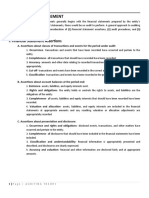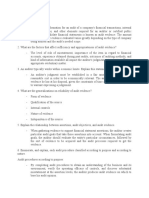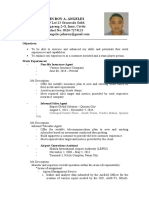Introduction To Auditing and Overview of The Audit Process
Uploaded by
Jamaica ManilaIntroduction To Auditing and Overview of The Audit Process
Uploaded by
Jamaica ManilaINTRODUCTION TO AUDITING AND OVERVIEW OF THE AUDIT PROCESS
A. AUDITING
As defined by the American Accounting Association, an audit is a systematic process of objectively obtaining and
evaluating evidence regarding assertions about economic actions and events to ascertain the degree of
correspondence between these assertions and established criteria and communicating the results thereof.
Types of audit
In compliance with the syllabus in Auditing of the Philippine CPA Licensure Examination, the following are the types
of audit.
1. Nature of assertion or data
a. Financial statement (FS) audit
b. Operational audit
c. Compliance audit
2. Types of auditors
a. External audit
b. Internal audit
c. Government audit
B. FINANCIAL STATEMENT AUDIT
PSA 120 dictates that the objective of an audit of financial statements is to enable the auditor to express an opinion
whether the financial statements are prepared, in all material respects, in accordance with generally accepted
accounting principles or other identified financial reporting framework.
PSA 200 (Revised and Redrafted) further supported the above objective by stating that “in conducting an audit of
financial statements, the overall objectives of the auditor are:
a. To obtain reasonable assurance about whether the financial statements as a whole are free from material
misstatement, whether due to fraud or error, thereby enabling the auditor to express an opinion on whether
the financial statements are prepared, in all material respects, in accordance with an applicable financial
reporting framework; and
b. To report on the financial statements, and communicate as required by the PSAs, in accordance with the
auditor’s findings.”
Review of elements of FS audit
A. A three-party relationship
B. An appropriate subject matter
C. Suitable criteria
D. Sufficient appropriate evidence
E. A written assurance report or conclusion.
Assurance provided by the auditor
The auditor’s opinion is intended to enhance the credibility of financial statements by providing a high,
but not absolute, level of assurance.
Reasonable assurance and the inherent limitations of an audit
a. Use of selective testing
b. Inherent limitations of internal control
c. Fact that most of audit evidence is persuasive rather than conclusive
d. Work undertaken by the auditor to form opinion is permeated by judgment
e. Nature/characteristics of assertions
Auditing and Assurance Principles
C. THE DEMAND FOR FS AUDIT
Management of the following
1. Business risk
Business risk, which is any event or activity that will prevent the entity in meeting its business objectives
such as wealth and profit maximization. If an entity is exposed to a very significant business risk, such risk
may ultimately lead the entity to fail. This is the primary reason why decisions to be made must be carefully
evaluated and should be founded on suitable basis.
Furthermore, investors, creditors, and other users of financial information demand high-quality, relevant,
and reliable information in order to come up with educated financial decisions.
2. Information risk
Information risk, the risk that the information prepared and presented by the entity contains misstatement.
Information risk is the mathematical complement of reliability level. This means that as information risk
increases (from 5% to 10%), reliability level decreases (from 95% to 90%).
Additional conditions creating the need for FS Audit
• Conflict of interest between the responsible party and the intended users of the financial statements
• Expertise.
• Remoteness of users.
• Financial consequence.
D. GENERAL PRINCIPLES OF AN FS AUDIT
Whenever FS audit are conducted, the following principles must be observed:
1. The auditor should comply with relevant ethical requirement (Code of Ethics).
2. The auditor should conduct an audit in accordance with Philippine Standards on Auditing.
3. The auditor should plan and perform the audit with an attitude of professional skepticism.
4. The auditor should exercise professional judgment.
5. The auditor should obtain sufficient appropriate audit evidence.
E. THEORETICAL FRAMEWORK OF FS AUDIT
Efforts have been made to formally create a conceptual structure for auditing financial statements. The
conceptual structure would include conditions that should exist whenever FS Audit is conducted to have a
favorable result.
The following are some of the assumptions, postulates or concepts included in this conceptual structure:
1. All financial data are verifiable through existence of supporting documents and records
2. Auditor should always maintain independence with respect to the financial statements under audit
3. No long-term conflict between the auditor and the client’s management
4. Audit benefits the public
5. Effective internal control system reduces the possibility of errors and fraud
F. AUDIT PROCESS: A GENERAL APPROACH
1. Entity prepares and presents financial statements
The financial statements are considered as assertions or representation made by the entity, through its
management and those charged with governance, as appropriate. These assertions may be explicitly or
implicitly included in the financial statements and may fall into the following categories (TAP):
Assertions about classes of Transactions and events for the period under audit (TOCCAC):
Auditing and Assurance Principles
✓ Occurrence - transactions and events that have been recorded have occurred and pertain to the entity.
✓ Completeness - all transactions and events that should have been recorded have been recorded.
✓ Cutoff - transactions and events have been recorded in the correct accounting period.
✓ Accuracy - amounts and other data relating to recorded transactions and events have been
recorded appropriately.
✓ Classification - transactions and events have been recorded in the proper accounts.
Assertions about Account balances at the period end (ACERV):
✓ Completeness - all assets, liabilities and equity interests that should have been recorded have been recorded.
✓ Existence - assets, liabilities, and equity interests exist.
✓ Rights and obligations - the entity holds or controls the rights to assets, and liabilities are the
obligations of the entity.
✓ Valuation and allocation - assets, liabilities, and equity interests are included in the financial
statements at appropriate amounts and any resulting valuation or allocation adjustments are
appropriately recorded.
Assertions about Presentation and disclosure (POCAC):
✓ Occurrence and rights and obligations - disclosed events, transactions, and other matters have
occurred and pertain to the entity.
✓ Completeness - all disclosures that should have been included in the financial statements
have been included.
✓ Accuracy and valuation - financial and other information are disclosed fairly and at appropriate amounts.
✓ Classification and understandability - financial information is appropriately presented and
described, and disclosures are clearly expressed.
2. The auditor performs audit procedures
To achieve the overall objectives of the audit, the auditor shall design and perform audit procedures which
enable the gathering of audit evidence. Procedures to be performed may be categorized into (1) major audit
procedures and (2) specific audit procedures.
Major audit procedures
1. Risk assessment procedures. The audit procedures performed to obtain an understanding of the entity
and its environment, including the entity’s internal control, to identify and assess the risks of material
misstatement, whether due to fraud or error, at the financial statement and assertion levels.
2. Test of controls. An audit procedure designed to evaluate the operating effectiveness of controls in
preventing, or detecting and correcting, material misstatements at the assertion level.
3. Substantive procedure. An audit procedure designed to detect material misstatements at the assertion
level. Substantive procedures comprise:
i. Tests of details (of classes of transactions, account balances, and disclosures), and
ii. Substantive analytical procedures.
Specific audit procedures
1. Inspection of Records or Documents. It consists of examining records or documents, whether internal
or external, in paper form, electronic form, or other media.
2. Inspection of Tangible Assets. It consists of physical examination of the assets.
3. Observation. It consists of looking at a process or procedure being performed by others.
4. Inquiry. It consists of seeking information of knowledgeable persons, both financial and non-financial,
throughout the entity or outside the entity. This procedure may be used extensively throughout the audit
as a complement of other audit procedures.
5. Confirmation. A specific type of inquiry that is the process of obtaining a representation of information or
of an existing condition directly from a third party.
6. Recalculation. It consists of checking the mathematical accuracy of documents or records. This
procedure may be performed manually or electronically.
7. Reperformance. It involves the auditor’s independent execution of procedures or controls that were
Auditing and Assurance Principles
originally performed as part of the entity’s internal control.
8. Analytical Procedures. Procedures consist of evaluations of financial information made by a study of
plausible relationships among both financial and non-financial data. Analytical procedures also
encompass the investigation of identified fluctuations and relationships that are inconsistent with other
relevant information or deviate significantly from predicted amounts.
3. The auditor gathers audit evidence
Through the procedures performed, the auditor obtains sufficient appropriate audit evidence to be able
to draw reasonable conclusions on which to base the audit opinion.
4. The auditor expresses an audit opinion
The auditor provides a written audit report containing a conclusion or an opinion regarding the fairness of
preparation and presentation of financial statements in accordance with the applicable financial reporting
framework. Opinion to be expressed by the auditor may include either of the following:
a. Unmodified opinion.
b. Modified opinion.
1. A choice between Qualified and Adverse.
2. A choice between Qualified and Disclaimer of opinion.
G. AUDIT PROCESS: A MORE DETAILED APPROACH
The specific sequence or order of activities in performing financial statements audit may vary from firms to firms
depending on their own policies and procedures. However, such sequence of different activities normally will include
the following steps:
PHASE DESCRIPTION
1. Preliminary This phase will require a decision from the auditor whether or not to accept a new
engagement client or continue relationship with an existing one. This process would require
activities evaluation not only of the auditor’s qualification, but also the integrity and
auditability of the client’s financial statements.
2. Planning an audit of Audit planning involves the development of an overall audit strategy, audit plan
financial statements and audit program. The auditor usually obtained more detailed knowledge about
the client’s business and industry in order to understand the transactions and
events affecting the financial statements.
Preliminary assessment of risk and materiality is also made during this phase.
3. Study and evaluation Since entity’s internal control directly affects the reliability of the financial
of internal control statements, it is appropriate to study and evaluate these controls.
4. Evidence- gathering Using the information obtained in audit planning and consideration of internal
(Substantive testing) controls, the auditor performs substantive test to determine whether entity’s
financial statements are presented fairly in accordance with financial reporting
standards. Substantive procedures could either be analytical procedures or test
of details of transactions and balances
This phase will always be performed by the auditor.
5. Completing the audit Wrapping-up procedures are performed; conclusions reached are reviewed; and
an overall opinion is formed during this phase.
6. Issuance of the audit In this stage, auditor prepares and issues audit report which describes the scope
report of the audit and states the auditor’s conclusion regarding the fairness of the
financial statements.
7. Post-audit After completion of the audit engagement, auditor performs procedures that will
responsibilities enable him/her identify areas for improvement in the current and future
engagements.
Auditing and Assurance Principles
You might also like
- Interview Questions As An Administrative OfficerNo ratings yetInterview Questions As An Administrative Officer2 pages
- Customer Perception Towards Online Shopping at Flipkart PDF100% (2)Customer Perception Towards Online Shopping at Flipkart PDF11 pages
- THE AUDIT PROCESS - Accepting An Engagement: Financial Statement Assertions100% (3)THE AUDIT PROCESS - Accepting An Engagement: Financial Statement Assertions24 pages
- 4 Auditing Principles and Practices-i Ch-4No ratings yet4 Auditing Principles and Practices-i Ch-425 pages
- Alan Fernandes (AUDIT EVIDENCE TO AUDIT REPORTING)No ratings yetAlan Fernandes (AUDIT EVIDENCE TO AUDIT REPORTING)28 pages
- AUDIT1. 4 The Audit Process Accepting An EngagementNo ratings yetAUDIT1. 4 The Audit Process Accepting An Engagement32 pages
- Module 1 BASIC CONCEPTS OF FINANCIAL STATEMENT AUDIT PDF100% (1)Module 1 BASIC CONCEPTS OF FINANCIAL STATEMENT AUDIT PDF8 pages
- Basic Concepts of Financial Statement Audit100% (3)Basic Concepts of Financial Statement Audit102 pages
- Concept of Audit and Assurance ServicesNo ratings yetConcept of Audit and Assurance Services24 pages
- Introduction To Financial Statement AuditNo ratings yetIntroduction To Financial Statement Audit28 pages
- Auditing: Fira Firmanila & Lyanda PasadhiniNo ratings yetAuditing: Fira Firmanila & Lyanda Pasadhini22 pages
- Chapter - 04, Process of Assurance - Evidence and ReportingNo ratings yetChapter - 04, Process of Assurance - Evidence and Reporting5 pages
- Audit Evidence Procedures and DocumentationNo ratings yetAudit Evidence Procedures and Documentation46 pages
- Introduction To Financial Statement AuditNo ratings yetIntroduction To Financial Statement Audit63 pages
- ACCA - Audit Evidence and The Objectives of An AuditNo ratings yetACCA - Audit Evidence and The Objectives of An Audit14 pages
- Lesson 1 - Overview of The Risk-Based Audit ProcessNo ratings yetLesson 1 - Overview of The Risk-Based Audit Process7 pages
- Pre-Test: Lesson 4: The Audit Process - Accepting An EngagementNo ratings yetPre-Test: Lesson 4: The Audit Process - Accepting An Engagement3 pages
- Week 1 Overview of Audit - ACTG411 Assurance Principles, Professional Ethics & Good GovNo ratings yetWeek 1 Overview of Audit - ACTG411 Assurance Principles, Professional Ethics & Good Gov6 pages
- Introduction To Financial Statement AuditNo ratings yetIntroduction To Financial Statement Audit49 pages
- UNESCO Working Group On Education: Digital Skills For Life and WorkNo ratings yetUNESCO Working Group On Education: Digital Skills For Life and Work128 pages
- Summary of Parcel of Land - Sally ZarragaNo ratings yetSummary of Parcel of Land - Sally Zarraga2 pages
- Department of MBA: Presentation On "Organizational Study at Chamundi Die Cast, TumkurNo ratings yetDepartment of MBA: Presentation On "Organizational Study at Chamundi Die Cast, Tumkur19 pages
- Template Memorandum and Articles of Association Limited by SharesNo ratings yetTemplate Memorandum and Articles of Association Limited by Shares19 pages
- Principlesof Accounts Curriculum Guide Grade 10No ratings yetPrinciplesof Accounts Curriculum Guide Grade 108 pages
- iOS Test Driven Development by Tutorials Second Edition By Joshua Greene & Michael Katzpdf download100% (1)iOS Test Driven Development by Tutorials Second Edition By Joshua Greene & Michael Katzpdf download30 pages
- Customer Perception Towards Online Shopping at Flipkart PDFCustomer Perception Towards Online Shopping at Flipkart PDF
- THE AUDIT PROCESS - Accepting An Engagement: Financial Statement AssertionsTHE AUDIT PROCESS - Accepting An Engagement: Financial Statement Assertions
- Alan Fernandes (AUDIT EVIDENCE TO AUDIT REPORTING)Alan Fernandes (AUDIT EVIDENCE TO AUDIT REPORTING)
- AUDIT1. 4 The Audit Process Accepting An EngagementAUDIT1. 4 The Audit Process Accepting An Engagement
- Module 1 BASIC CONCEPTS OF FINANCIAL STATEMENT AUDIT PDFModule 1 BASIC CONCEPTS OF FINANCIAL STATEMENT AUDIT PDF
- Chapter - 04, Process of Assurance - Evidence and ReportingChapter - 04, Process of Assurance - Evidence and Reporting
- ACCA - Audit Evidence and The Objectives of An AuditACCA - Audit Evidence and The Objectives of An Audit
- Lesson 1 - Overview of The Risk-Based Audit ProcessLesson 1 - Overview of The Risk-Based Audit Process
- Pre-Test: Lesson 4: The Audit Process - Accepting An EngagementPre-Test: Lesson 4: The Audit Process - Accepting An Engagement
- Week 1 Overview of Audit - ACTG411 Assurance Principles, Professional Ethics & Good GovWeek 1 Overview of Audit - ACTG411 Assurance Principles, Professional Ethics & Good Gov
- UNESCO Working Group On Education: Digital Skills For Life and WorkUNESCO Working Group On Education: Digital Skills For Life and Work
- Department of MBA: Presentation On "Organizational Study at Chamundi Die Cast, TumkurDepartment of MBA: Presentation On "Organizational Study at Chamundi Die Cast, Tumkur
- Template Memorandum and Articles of Association Limited by SharesTemplate Memorandum and Articles of Association Limited by Shares
- iOS Test Driven Development by Tutorials Second Edition By Joshua Greene & Michael Katzpdf downloadiOS Test Driven Development by Tutorials Second Edition By Joshua Greene & Michael Katzpdf download





























































































